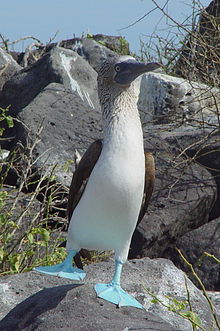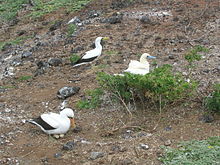
Booby
Background Information
SOS Children, which runs nearly 200 sos schools in the developing world, organised this selection. Child sponsorship helps children one by one http://www.sponsor-a-child.org.uk/.
| Booby | |
|---|---|
 |
|
| Blue-footed Booby displaying by raising a foot | |
| Scientific classification | |
| Kingdom: | Animalia |
| Phylum: | Chordata |
| Class: | Aves |
| Order: | Suliformes |
| Family: | Sulidae |
| Genus: | Sula Brisson, 1760 |
| Species | |
For fossil species, see text. |
|
A booby is a seabird in the genus Sula, part of the Sulidae family. Boobies are closely related to the gannets (Morus), which were formerly included in Sula.
Description
Boobies hunt fish by diving from a height into the sea and pursuing their prey underwater. Facial air sacs under their skin cushion the impact with the water. Boobies are colonial breeders on islands and coasts. They normally lay one or more chalky-blue eggs on the ground or sometimes in a tree nest.
Name
Their name was possibly based on the Spanish slang term bobo, meaning "stupid", as these tame birds had a habit of landing on board sailing ships, where they were easily captured and eaten. Owing to this, boobies are often mentioned as having been caught and eaten by shipwrecked sailors, notably William Bligh of the Bounty and his adherents, during their famous voyage after being set adrift by Fletcher Christian and his followers.
Systematics and evolution
Six of the seven extant Sulidae species called boobies are in the genus Sula, while the three gannet species are usually placed in the genus Morus. Abbott's Booby was formerly included in Sula but is now placed in a monotypic genus Papasula, which represents an ancient lineage perhaps closer to Morus.
Some authorities consider that all nine species should be considered congeneric in Sula. However, they are readily told apart, by means of osteology. The distinct lineages of gannets and boobies are known to have existed in such form, since at least the Middle Miocene, c.15 mya (Olson 1985).
The fossil records of boobies are not as well documented as those of the gannets; possibly because the species of boobies were less numerous in the late Miocene to Pliocene, when gannets had their highest diversity or because of the more tropical distribution of boobies, many fossil species have simply not been found yet, as most localities are in continental North America or Europe.


